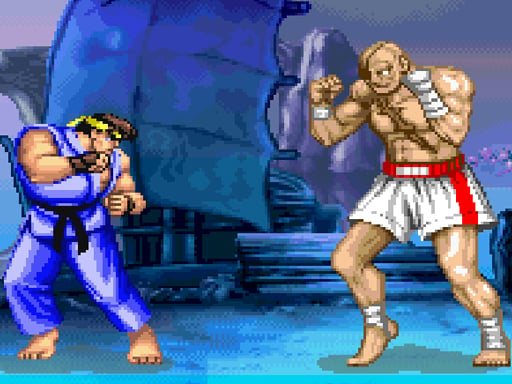Street Fighter 2 Arcade Revival Guide

How to Play
Overview
Street Fighter 2 remains the arcade benchmark that taught an entire generation what responsive combat and layered mind games feel like. The game funnels you straight from character select into a duel where every punch, fireball, and micro-step telegraphs intent, so this guide starts by decoding those signals the way a veteran coach would.
Instead of recycling marketing blurbs, Street Fighter 2 coverage here examines input latency, crowd control, and match pacing in plain language. When Street Fighter 2 runs inside a modern browser through GameMonetize, it still rewards timing discipline, so every section leads with actionable settings tweaks and warns where panic mashing collapses a round.
History & Legacy
Street Fighter 2 launched in 1991, yet the competitive skeleton it created still powers major tournaments and local weeklies alike. The release standardized best-of-three sets, mirror-match fairness, and fireball zoning, and those bones underpin nearly every contemporary 2D fighter released since.
Ryu and Sagat remain the perfect teaching duo because every Street Fighter 2 match between them showcases spacing, meter awareness, and punish windows without filler. When the arcade hit migrated from cabinets to consoles and online hubs, that rivalry stayed relevant, so this blog distills why the matchup endures and how to translate its lessons to other roster staples.
Core Loop
Street Fighter 2 thrives on a three-step loop: open with scouting, convert distance into pressure, and cash out with a safe finisher. This loop only shines when you read wake-up tendencies, buffer the correct counter, and adjust mid combo rather than autopiloting memorized strings.
Because Street Fighter 2 enforces a strict timer, you must manage risk like an engineer balancing throughput. If Street Fighter 2 detects you chasing flashy confirms instead of guaranteed damage, savvy opponents retaliate with ruthless reversals, so this section lists the high-value confirms worth drilling.
Moveset Fundamentals
Every Street Fighter 2 character depends on reliable motion inputs and precise spacing discipline. Veterans tap quarter-circle motions without conscious thought, yet newcomers need a structured approach that treats motions like repeatable unit tests.
- Street Fighter 2 fireballs: Build muscle memory around travel speed, recovery frames, and how the engine lets you trap jumps at mid screen when the opponent hesitates.
- Street Fighter 2 anti-airs: Catalog which normals or specials beat common jump arcs so the AI punishes telegraphed leaps instead of trading damage.
- Street Fighter 2 footsies: Practice low forward spacing and walk-up throws until neutral exchanges feel like deliberate chess rather than coin flips.
Stick with training mode until Street Fighter 2 motions feel automatic and your counter-hit conversions no longer drop. The game only rewards creativity after the fundamentals become boringly consistent, so grind the essential reps early.
How to Play
Sync the video clip with this Street Fighter 2 checklist: watch the opener, pause, note the spacing, and predict the next three actions before unpausing. When the footage demonstrates a punish sequence, replay it in training mode immediately so muscle memory forms while the visual cue stays fresh.
Strategy Pillars
- Street Fighter 2 tempo: Control the mid-screen rhythm by alternating between safe pokes and walk-back baits until opponents whiff something reckless.
- Street Fighter 2 meter: Track super gauge as a resource, because a well-timed cancel flips entire rounds when deployed after a confirmed hit.
- Street Fighter 2 defense: Rotate between blocking, teching throws, and reversal attempts so rivals never label you a predictable turtle.
Training Drills
Divide Street Fighter 2 practice into fifteen-minute blocks: five minutes on motion cleanup, five on hit-confirm timing, five on reaction tests. The game rewards short, intense bursts far more than grueling marathons that build bad habits.
Log every Street Fighter 2 set you play, annotate where a round flipped, and tag patterns such as missed anti-airs or unsafe sweeps. When Street Fighter 2 exposes a repeated flaw, script a drill that attacks the weakness directly, then re-measure during the next session.
Competitive Mindset
Street Fighter 2 veterans stay calm because they treat each round like a debugging session rather than a brawl. The title punishes emotional tilts instantly, so reset your breathing, re-evaluate matchup notes, and treat losses as data.
Bring the same discipline to hardware and netplay prep. Street Fighter 2 suffers when controller dead zones or browser throttling creep in, so audit your setup, test input delay, and ensure the client runs without background clutter before queueing ranked lobbies.
FAQ
- How do I pick a main in Street Fighter 2?
Sample every roster slot, but settle on the character whose gameplan you can explain in one sentence, then grind that plan until counters feel manageable.
- How can I climb faster in Street Fighter 2?
Review match replays nightly, label three decision errors, and plug the leaks with targeted drills so rank climbs become predictable instead of streaky.
- What gear helps Street Fighter 2 play best?
Any reliable gamepad or stick works if inputs register without drops, so prioritize stable USB connections, 60 FPS monitors, and browsers tuned for low latency.